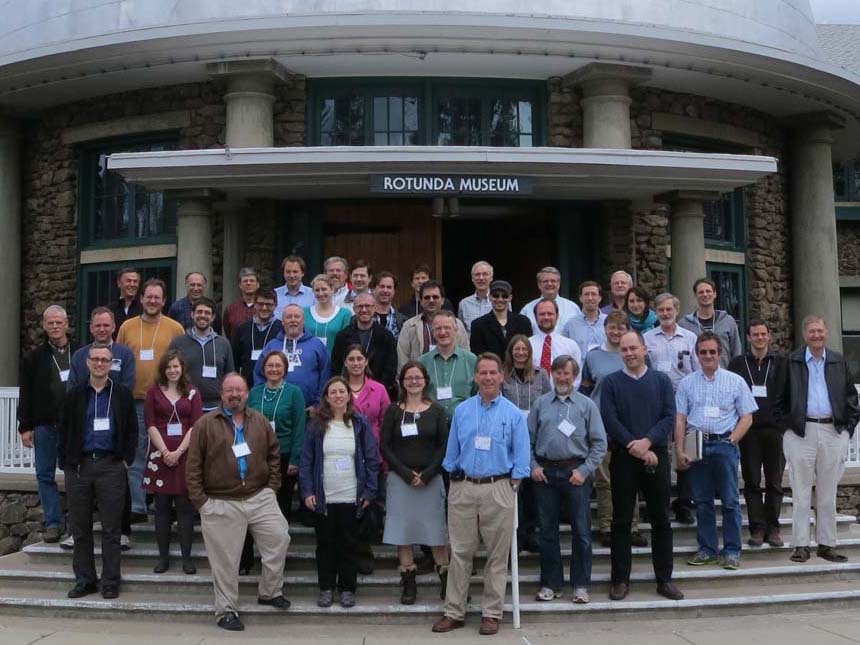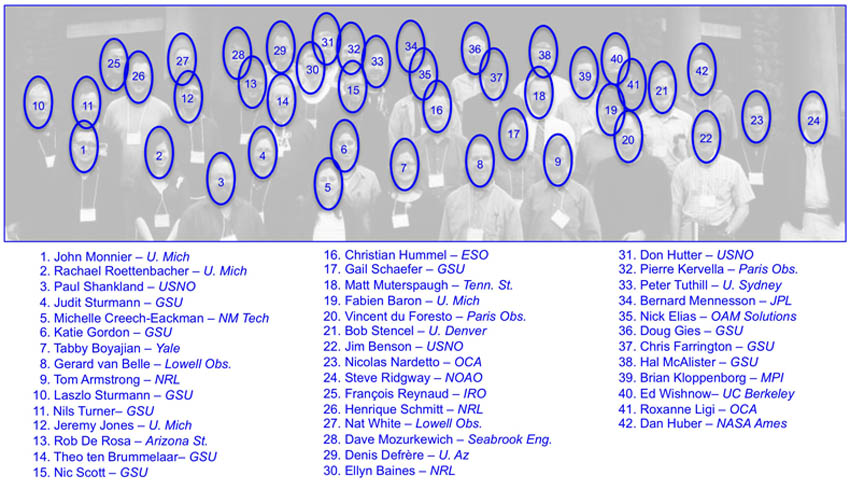This year, CHARA joined forces with astronomers from the Navy Precision Optical Interferometer to discuss scientific and technical issues of common interest. Participants included representatives from the University of Arizona, Observatoire de la Côte d'Azur, University of Denver, European Southern Observatory, Georgia State University, Goddard Space Flight Center, Jet Propulsion Laboratory, University of Limoges, Lowell Observatory, Max Planck Institute for Radio Astronomy, University of Michigan, NASA Ames Research Center, National Optical Astronomy Observatory, Naval Research Laboratory, New Mexico Institute of Mining and Technology, Paris Observatory, University of Sydney, Tennessee State University, U.S. Naval Observatory and Yale University.
This meeting was particularly meaningful for the undersigned, since it was 30 years ago this year that CHARA was established as a research center at Georgia State. Looking back at those early days, the seemingly very exciting science we then envisioned has turned out to be far less imaginitive in terms of breadth and depth compared with what has actually resulted from the efforts of the many wonderful users of the CHARA Array during the decade it has been scientifically operational. Getting together this year with our interferometry colleagues from other facilities, existing and planned, in the U.S. and Europe has been an inspirational experience. While interferometry is still emerging as a widely practiced field in astronomy, it seems inevitable that, once sensitivity is routinely extended a few magnitudes to encompass more of the Universe, very high resolution astronomy will find its rightful role in the arsenal of astronomical research tools.
Immediately prior to this meeting, an "Interferometry Forum" was held on March 14 & 15 with representatives of the various interferometry groups discussing issues of common concern internationally regarding immediate funding situations, future directions for the field, and manners by which we can cooperate to advance high-spatial resolution astronomy. Steve Ridgway gave a report on the Forum to the larger group on March 20.
We are all grateful to Lowell Astronomer Gerard van Belle who so expertly organized the meeting, to CHARA Associate Director Theo ten Brummelaar for putting together the science program and organizing the speakers, and to Lowell Observatory Director Jeff Hall for his hospitality in welcoming us to Flagstaff.
Meeting participants are shown in the photograph below taken in front of the Slipher Building at Lowell. Following that are the individual presentations in PDF format. Click on each title to view the full presentation. Some files are quite large, so be patient as they download.
H.A. McAlister 1 April 2013
Group photo


Talks
| Topic |
Speaker |
| Some Introductory Comments |
Hal McAlister, GSU/CHARA, Atlanta |
| Upgrades in the Laboratory |
Judit Sturmann, GSU/CHARA, Mount Wilson |
| Upgrades and Fixes |
Laszlo Sturmann, GSU/CHARA, Mount Wilson |
| Classic/CLIMB Magnitude Limits, Throughput, and the Baseline Solution |
Theo ten Brummelaar, GSU/CHARA, Mount Wilson |
| Weather and Seeing Statistics |
Nils Turner, GSU/CHARA, Mount Wilson |
| VEGA: Status and Future Plans |
Nicolas Nardetto, OCA, Nice |
| JouFLU: an Upgraded FLUOR Beam Combiner at the CHARA Array |
Nic Scott, GSU/CHARA, Atlanta |
| MIRC/CHAMP Update |
John Monnier, U. Michigan, Ann Arbor |
| NPOI Update |
Don Hutter, USNO, Flagstaff |
| Plans for Installation of 1.8-m Telescopes at the NPOI |
Paul Shankland, USNO, Flagstaff |
| New Delay Line Control System at the NPOI |
Tim Buschmann, USNO, Flagstaff |
| Update on VISION at NPOI |
Matt Muterspaugh, TSU, Nashville |
| Progress on the UNAC |
Jim Benson, USNO, Flagstaff |
| SUSI Update |
Peter Tuthill, U. Sydney, Sydney |
| VLTI Update |
Christian Hummel, ESO, Garching |
| MROI Update |
Michelle Creech-Eakman, New Mexico Tech, Socorro |
| ISI Update |
Ed Wishnow, UC, Berkeley |
| A NASA Origins Proposal to Help Expand the CHARA/FLUOR Hot Disk Survey |
Bertrand Mennesson, JPL, Pasadena |
| Present Status on the Implementation of an Up-Conversion Interferometer on CHARA |
Francois Reynaud, U. Limoges, France |
| Binary Star Studies with NPOI |
Christian Hummel, ESO, Garching |
| Long-Term Massive Binary Monitoring, Scheduling 2013, and the Control Room Upgrade |
Chris Farrington, GSU/CHARA, Mount Wilson |
| MIRC Observations of the O-Star Triple System sigma Orionis |
Gail Schaefer, GSU/CHARA, Mount Wilson |
| Fundamental Properties of O and B Stars |
Kathryn Gordon, GSU/CHARA, Atlanta |
| A CHARA Array Survey of Cirsumstellar Disks Around Nearby Be-Type Stars |
Doug Gies, GSU/CHARA, Atlanta |
| How Old Are the A Stars? |
Jeremy Jones, GSU/CHARA, Atlanta |
| Ongoing Reduction of PTI Giant Diameters |
Gerard van Belle, Lowell Obs, Flagstaff |
| Stellar Angular Diameters from CHARA and NPOI Data |
Ellyn Baines, Naval Research Lab, Washington |
| The Evolutionary State of HR 7955 |
Tom Armstrong, USNO, Flagstaff |
| MIRC Imaging of Two Red Supergiants from the Double Cluster |
Fabien Baron, U. Michigan, Ann Arbor |
| Imaging the Starspots on omicron Draconis |
Rachael Roettenbacher, U. Michigan, Ann Arbor |
| Diameters and Temperatures of Main Sequence Stars: The Big Picture |
Tabetha Boyajian, Yale U, New Haven |
| The CHARA/FLUOR Survey of Debris Disk Stars: Results and Statistics |
Denis Defrère, U. Ariz |
| The Warm Component of Debris Disks LBTI Science Team |
Bill Danchi, GSFC, Greenbelt |
| Update on the epsilon Aurigae Using Multi-Epoch Interferometry |
Bob Stencel, U. Denver, Denver |
| The CHARA, NPOI, and PTI View of epsilon Aurigae and a Preview of EXor Observations |
Brian Kloppenborg, MPIfR, Bonn |
| PAVO Follow-Up Observations of Kepler Stars |
Daniel Huber, NASA Ames |
| Exoplanet Host Stars with VEGA/CHARA |
Roxanne Ligi, OCA, Nice |
| Recent Results in the Cepheid Program |
Pierre Kervella, Paris Obs, Paris |
| Astrophotonic Quantum Astronomy: Reverse the Photon Polarity, Captain! |
Peter Tuthill, U. Sydney, Sydney |
| Future Instrumention Plan for NPOI |
Don Hutter, USNO, Flagstaff |
| Future Instrumention Plan for CHARA |
Theo ten Brummelaar, GSU/CHARA, Mount Wilson |
| Interferometry Forum Report |
Steve Ridgway, NOAO, Tucson |





